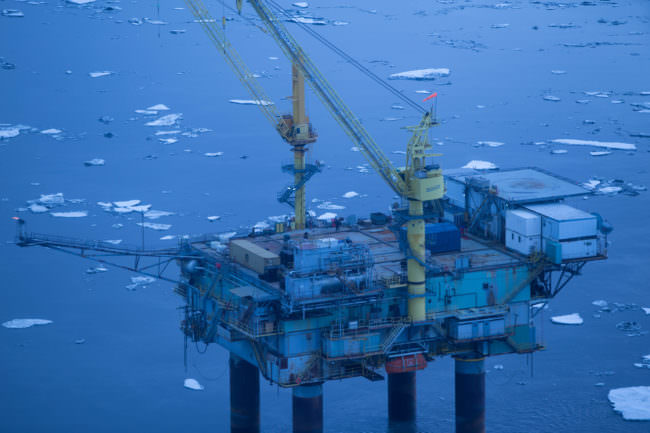
State regulators on Monday announced an oil leak from an underwater pipeline owned by Hilcorp in Cook Inlet was halted successfully.
But at this point, the state doesn’t have its own estimate for how much oil was released into the Inlet or knowledge of what caused the leak. It’s the latest in a string of incidents associated with Hilcorp, and the company is facing a wave of scrutiny from both regulators and environmental groups.
As of Monday, no one knows what hit Hilcorp’s Anna Platform in upper Cook Inlet on April 1. All that’s known is that workers felt an impact, then looked over the side of the platform to see every oil company’s worst nightmare: an oil sheen on the water.
Overflights conducted later that day observed six sheens; the biggest was 10 feet by 12 feet. The company thinks the leak came from an 8-inch pipeline which was at maximum capacity, carrying more than 19,000 gallons of crude oil when the impact happened.
Hilcorp shut down the oil platform, and on Sunday, the company put what’s called a pig through the oil line. This halted the leak and pushed the remaining crude into a holding tank. No sheens have been observed since Saturday.
Hilcorp estimates less than 10 gallons was released, based on the size and number of the oil sheens it observed. But the state said it still needs to do some arithmetic. Kristin Ryan is director of the Alaska Department of Environmental Conservation’s Division of Spill Prevention and Response.
“We’ll be looking at the volume of the line and the amount of oil they removed from the line and then try to determine what’s missing,” Ryan said.
Ryan said the state hasn’t observed any impacts to wildlife. But she added there’s likely to be a penalty, based on the final calculation of the volume of oil released.
“We have a zero tolerance for oil in the environment, and the release of oil is something we take very seriously. So yes, I assume there will be a penalty, which is a fine for this release,” Ryan said.
Hilcorp is already dealing with another unrelated incident in Cook Inlet, a natural gas leak from a different pipeline. That leak started in December and is ongoing. Divers have been unable to fix the gas leak for weeks due to dangerous ice conditions in Cook Inlet. After talks with Governor Bill Walker, Hilcorp recently agreed to shut down the oil platform associated with the leak.
While various pieces of equipment have been upgraded over the years, much of the oil and gas infrastructure in Cook Inlet was first installed in the 1960s.
Ryan said there’s no indication at this point that Hilcorp was operating the oil pipeline outside of the state’s standards. Hilcorp reports it inspected the line in June 2016 and found it was in good condition.
But Ryan added it’s time for state regulators to take a holistic look at Cook Inlet’s aging infrastructure, to “try to have a better record of what pipes are where, who owns them, how old are they, what’s their inspection frequency.”
Over the next year, Ryan said the state will work with the Cook Inlet Regional Citizens Advisory Council to compile an updated report on the age and status of the Inlet’s oil and gas operations. Based on that report, Ryan said the state may decide to change its regulations.
Hilcorp, which is based in Texas, is now the biggest oil and gas producer in Cook Inlet, having bought up a lot of the old infrastructure from other companies in recent years. It also operates on the North Slope.
If Hilcorp is fined for the oil leak, it wouldn’t be a first. Over the past year, the Alaska Oil and Gas Conservation Commission penalized Hilcorp multiple times for safety incidents. In March, the Commission fined Hilcorp $200,000 for a 2015 incident on the North Slope that nearly resulted in the deaths of three workers.
Hilcorp turned down requests for interviews on both the gas leak and the oil leak.
To say the fines, the ongoing gas leak and the oil leak have alarmed environmental groups would be an understatement. Among the many species that live in Cook Inlet, the body of water is home to a population of beluga whales which is listed as endangered.
“We’ve seen a toxic corporate culture here,” Bob Shavelson of Cook Inletkeeper said. The group has threatened to sue Hilcorp over the gas leak.
“We’ve seen a complete disregard for worker safety and environmental protection,” Shavelson added.
As the state takes closer look at aging infrastructure in Cook Inlet, environmental groups are ramping up their scrutiny of all of Hilcorp’s operations.
Elizabeth Harball is a reporter with Alaska's Energy Desk, covering Alaska’s oil and gas industry and environmental policy. She is a contributor to the Energy Desk’s Midnight Oil podcast series. Before moving to Alaska in 2016, Harball worked at E&E News in Washington, D.C., where she covered federal and state climate change policy. Originally from Kalispell, Montana, Harball is a graduate of Columbia University Graduate School of Journalism.




